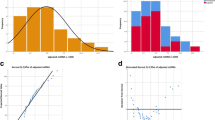Abstract
Behind every successful IVF embryo transfer, there is a great game of chance. Methods seeking to tilt the balance and increase the likelihood of implantation have been proposed and implemented with varying results, including embryo morphology, FISH-PGS, comprehensive chromosomal screening (CCS), morphokinetics, endometrial receptivity testing. It has been suggested that mitochondrial DNA (mtDNA) copy number could serve as a biomarker for embryo viability, but this concept was recently challenged. The world of IVF is left with unanswered questions: Why are there discrepancies in the reports? Should mtDNA copy number be considered to rank embryos for transfer? And in a broader sense, how well must a technique be validated before its implementation in the IVF clinic? Here, we explore these questions attempting to piece together the published data and suggest future directions to help unravel the subject matter.

Similar content being viewed by others
References
Chan DC. Mitochondria: dynamic organelles in disease, aging, and development. Cell. 2006;125(7):1241–52. https://doi.org/10.1016/j.cell.2006.06.010.
Seli E. Mitochondrial DNA as a biomarker for in-vitro fertilization outcome. Curr Opin Obstet Gynecol. 2016;28(3):158–63. https://doi.org/10.1097/GCO.0000000000000274.
Wai T, Ao A, Zhang X, Cyr D, Dufort D, Shoubridge EA. The role of mitochondrial DNA copy number in mammalian fertility. Biol Reprod. 2010;83(1):52–62. https://doi.org/10.1095/biolreprod.109.080887.
Fragouli E, Spath K, Alfarawati S, Kaper F, Craig A, Michel CE, et al. Altered levels of mitochondrial DNA are associated with female age, aneuploidy, and provide an independent measure of embryonic implantation potential. PLoS Genet. 2015;11(6):e1005241. https://doi.org/10.1371/journal.pgen.1005241.
Diez-Juan A, Rubio C, Marin C, Martinez S, Al-Asmar N, Riboldi M, et al. Mitochondrial DNA content as a viability score in human euploid embryos: less is better. Fertil Steril. 2015;104(3):534–41.e1. https://doi.org/10.1016/j.fertnstert.2015.05.022.
Leese HJ. Quiet please, do not disturb: a hypothesis of embryo metabolism and viability. BioEssays. 2002;24(9):845–9. https://doi.org/10.1002/bies.10137.
Victor AR, Brake AJ, Tyndall JC, Griffin DK, Zouves CG, Barnes FL, et al. Accurate quantitation of mitochondrial DNA reveals uniform levels in human blastocysts irrespective of ploidy, age, or implantation potential. Fertil Steril. 2017;107(1):34–42.e3. https://doi.org/10.1016/j.fertnstert.2016.09.028.
Treff NR, Zhan Y, Tao X, Olcha M, Han M, Rajchel J, et al. Levels of trophectoderm mitochondrial DNA do not predict the reproductive potential of sibling embryos. Hum Reprod. 2017;32(4):954–62. https://doi.org/10.1093/humrep/dex034.
Ravichandran K, McCaffrey C, Grifo J, Morales A, Perloe M, Munne S et al. Mitochondrial DNA quantification as a tool for embryo viability assessment: retrospective analysis of data from single euploid blastocyst transfers. Hum Reprod. 2017:1–11. doi:https://doi.org/10.1093/humrep/dex070.
Fragouli E, McCaffrey C, Ravichandran K, Spath K, Grifo JA, Munné S, Wells D. Clinical implications of mitochondrial DNA quantification on pregnancy outcomes: a blinded prospective non-selection study. Hum Reprod. 2017;1-8. https://doi.org/10.1093/humrep/dex292.
Hornak M, Horak J, Kubicek D, Travnik P, Vesely J, Vesela K. Mitochondria quantification in human IVF embryos using next-generation sequencing-based protocol. Bologna: Preimplantation Genetic Diagnosis International Society (PGDIS); 2016.
Ogur C, Gultomruk M, Caferler J, Capar B, Findikli N, Bahceci M. Maternal age has no influence on mitochondrial DNA (mtDNA) content in chromosomally normal embryos. Valencia: Preimplantation Genetic Diagnosis International Society (PGDIS); 2017.
De Los Santos MJ, Mercader A, Delgado A, Escrich L, Buendia P, Rubio C, et al. Mitochondrial DNA copy number measured by mitoscore is associated to trophectoderm quality. Valencia: Preimplantation Genetic Diagnosis International Society (PGDIS); 2017.
Hirai K, Aliev G, Nunomura A, Fujioka H, Russell RL, Atwood CS, et al. Mitochondrial abnormalities in Alzheimer’s disease. J Neurosci. 2001;21(9):3017–23.
Reznik E, Miller ML, Senbabaoglu Y, Riaz N, Sarungbam J, Tickoo SK et al. Mitochondrial DNA copy number variation across human cancers. Elife. 2016;5. doi:https://doi.org/10.7554/eLife.10769.
Deleye L, De Coninck D, Christodoulou C, Sante T, Dheedene A, Heindryckx B, et al. Whole genome amplification with SurePlex results in better copy number alteration detection using sequencing data compared to the MALBAC method. Sci Rep. 2015;5:11711. https://doi.org/10.1038/srep11711.
Hormozdiari F, Alkan C, Ventura M, Hajirasouliha I, Malig M, Hach F, et al. Alu repeat discovery and characterization within human genomes. Genome Res. 2011;21(6):840–9. https://doi.org/10.1101/gr.115956.110.
Mills RE, Bennett EA, Iskow RC, Devine SE. Which transposable elements are active in the human genome? Trends Genet. 2007;23(4):183–91. https://doi.org/10.1016/j.tig.2007.02.006.
Wildschutte JH, Baron A, Diroff NM, Kidd JM. Discovery and characterization of Alu repeat sequences via precise local read assembly. Nucleic Acids Res. 2015;43(21):10292–307. https://doi.org/10.1093/nar/gkv1089.
Scott RT Jr. Enhanced techniques to “power” embryonic mitochondria research. Fertil Steril. 2017;107(1):59–60. https://doi.org/10.1016/j.fertnstert.2016.11.024.
Author information
Authors and Affiliations
Corresponding author
Rights and permissions
About this article
Cite this article
Viotti, M., Victor, A.R., Zouves, C.G. et al. Is mitochondrial DNA quantitation in blastocyst trophectoderm cells predictive of developmental competence and outcome in clinical IVF?. J Assist Reprod Genet 34, 1581–1585 (2017). https://doi.org/10.1007/s10815-017-1072-6
Received:
Accepted:
Published:
Issue Date:
DOI: https://doi.org/10.1007/s10815-017-1072-6




